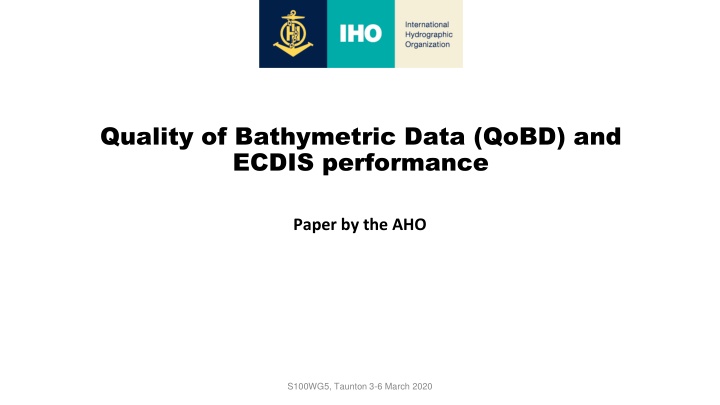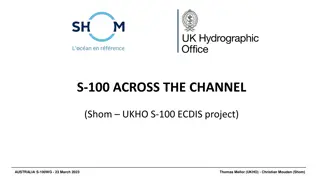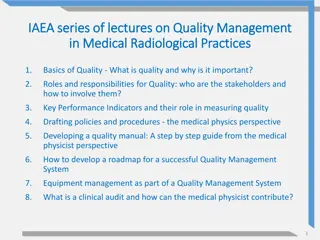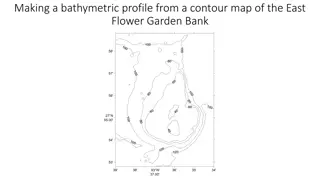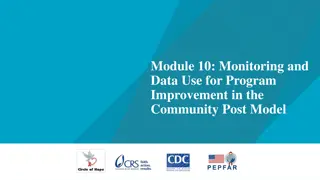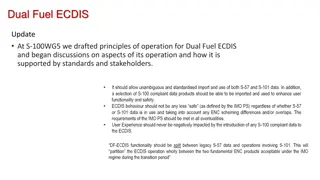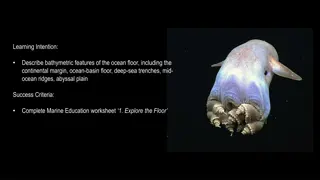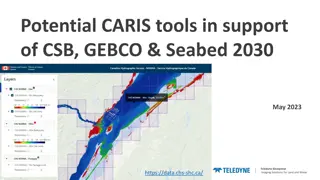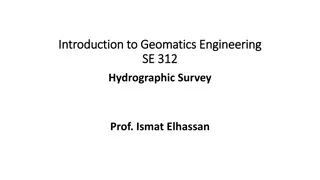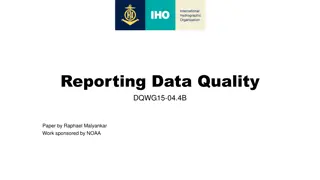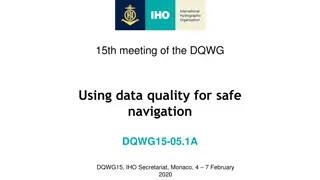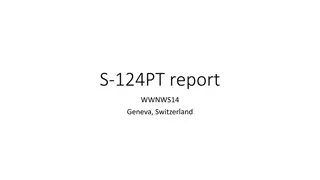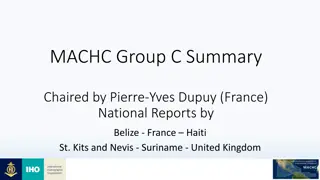Enhancing Bathymetric Data Quality for ECDIS Performance
The paper discusses the Quality of Bathymetric Data (QoBD) concept in relation to ECDIS performance, introducing new attributes like category of temporal variation. Current limitations and proposals for modifying decision trees and enabling automatic downgrading of QoBD in dynamic areas are explored. The aim is to improve mariners' confidence in charted depths and contours by providing more accurate and relevant data.
Download Presentation

Please find below an Image/Link to download the presentation.
The content on the website is provided AS IS for your information and personal use only. It may not be sold, licensed, or shared on other websites without obtaining consent from the author.If you encounter any issues during the download, it is possible that the publisher has removed the file from their server.
You are allowed to download the files provided on this website for personal or commercial use, subject to the condition that they are used lawfully. All files are the property of their respective owners.
The content on the website is provided AS IS for your information and personal use only. It may not be sold, licensed, or shared on other websites without obtaining consent from the author.
E N D
Presentation Transcript
Quality of Bathymetric Data (QoBD) and ECDIS performance Paper by the AHO S100WG5, Taunton 3-6 March 2020
The situation When compared to its S-57 equivalent object (M_QUAL), the S101 feature Quality of Bathymetric Data (QoBD) includes a new attribute called category of temporal variation which main purpose is to inform mariners about the changeability of the bathymetry in an area. Although not fully decided yet, it looks like certain combinations of the QoBD attribute values features detected, vertical uncertainty and horizontal position uncertainty would be grouped into QoBD categories (1 to 5) and these would end up driving portrayal. This would work as the S-57 s concept of Zone Of Confidence. The QoBD decision tree developed by the DQWG was introduced to help with the conversion from S-57 s M_QUAL objects to S-101 s QoBD features. The proposal includes the use of the new attribute category of temporal variation at the beginning of the process. S1000WG5, Taunton 3-6 March 2020
The situation S1000WG5, Taunton 3-6 March 2020
Limitations Currently charted CATZOC A1 areas that may now be attributed as likely to change and significant shoaling expected could only be mapped to QoBD=4 (CATZOC=C). This also applies to new surveys conducted to very high standards in areas of continuous change. Although the data can be very accurate for many months, it wouldn t be possible to allocate it to the QoBD=1 category. This would affect portrayal and the confidence mariners allocate to the data in the area. Category of temporal variation is only used at the moment of categorising the data for the first time but it is not used to update the quality of the data as time goes by. Mariners are expected to use thisattribute, the date the bathymetry was collected and the current date, to mentally downgrade the level of reliability they allocate to the charted depths and contours. S1000WG5, Taunton 3-6 March 2020
Proposal Modify the decision tree by removing category of temporal variation as follows: S1000WG5, Taunton 3-6 March 2020
Proposal Enable S100 ECDIS to automatically downgrade QoBD in areas likely to change based on: o the end date of a survey o the attribute category of temporal variation o the temporal validity of the survey (Proposed new attribute) o the maximum degree of change expected (Proposed new attribute lowest QoBD category ) S1000WG5, Taunton 3-6 March 2020
Proposed logic for the downgrading of QoBD: S1000WG5, Taunton 3-6 March 2020
Practical example Based on the use of the new proposed attributes and performance expectations, ECDIS should be able to downgrade category of QoBD as per the logical sequence described in the following example: ENC setting: S101 QoBD is encoded with: category of temporal variation= 2; temporal validity=7; data assessment=1; least depth of detected features=True; significant features detected= True; full seafloor coverage achieved= True; horizontal position uncertainty uncertainty fixed= 2; survey date end= 20190101; vertical uncertainty uncertainty fixed=0.3; lowest QoBD category= 4 ECDIS expected performance: When ECDIS date is set to a value earlier than survey end, QoBD should display using the symbology corresponding to category of QoBD= 1 When ECDIS date is set to a date more than 7 months later than survey date end (> 20190801), the attributes features detected, vertical uncertainty and horizontal position uncertainty would be downgraded by ECDIS to a value worse (just over or worst case scenario ??) than the minimum required. Based on this, QoBD display should change to the symbology corresponding to category of QoBD= 3. When ECDIS date is set to a date more than 14 months (2 x temporal validity) later than survey date end (>20200301), QoBD data symbology should change to the one corresponding to category of QoBD= 4. This would be the consequence of downgrading the values corresponding to the attributes features detected, vertical uncertainty and horizontal position uncertainty. Note that category of QoBD must not be downgraded to 5 due to the restriction imposed by the attribute lowest QoBD category. S1000WG5, Taunton 3-6 March 2020
Proposal - ECDIS warnings ECDIS should be able to forecast, display and trigger warnings at the route planning stage using the date and time of the waypoints along the route. S100 ECDIS in-built safety functions should interact with category of QoBD and trigger warnings when, either at planning or monitoring stages, a ship s route is to enter an area where the category of QoBD is worse than a pre-set value. S1000WG5, Taunton 3-6 March 2020
CONCLUSIONS o S100 ECDIS should be able to automatically downgrade QoBD and therefore have a direct impact on display, route planning and route monitoring (particularly in areas where bathymetry is affected by a high rate of temporal variation). o Automated functions related to the management and display of QoBD in S100 ECDIS will reduce mariners workload during route planning and monitoring facilitating their awareness and decision-making processes. All this should mitigate risk and have a positive impact on safety of navigation. o Although in theory the manual downgrading of QoBD attributes based on time, etc could be performed onshore by HO s and released as ENC updates, in practice it becomes a logistic nightmare. This approach would certainly delay the availability of changes and won t be able to assist mariners during route planning. S1000WG5, Taunton 3-6 March 2020
